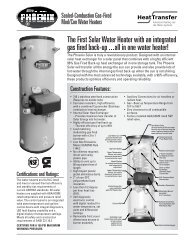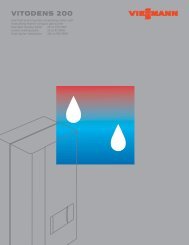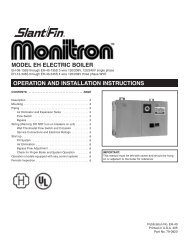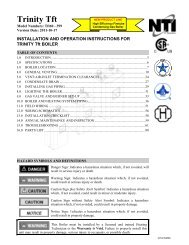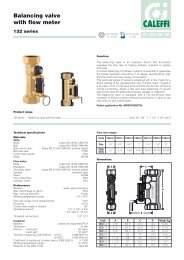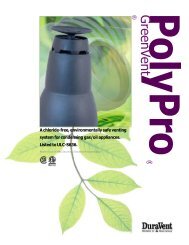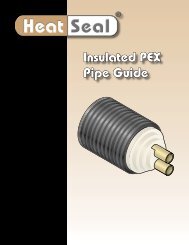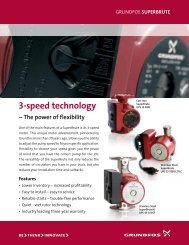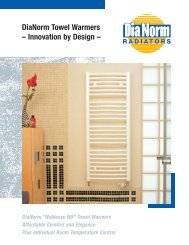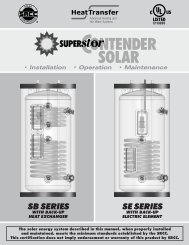Apricus Solar Water Heating System Installation and Operation ...
Apricus Solar Water Heating System Installation and Operation ...
Apricus Solar Water Heating System Installation and Operation ...
Create successful ePaper yourself
Turn your PDF publications into a flip-book with our unique Google optimized e-Paper software.
<strong>Apricus</strong> <strong>Solar</strong> Collector <strong>Installation</strong> & <strong>Operation</strong> Manual - USA7.7. Pump <strong>Operation</strong>a) Fixed Speed <strong>Operation</strong>: The <strong>Apricus</strong> closedloop pump station is supplied st<strong>and</strong>ard with a 3speed Grundfos pump. The speed used willdepend on the system head (line pressure losses).See pump specification sheet in Appendix 8.i) Measuring Flow Rate: By utilizing the flowmeter above the pump the flow can bemonitored <strong>and</strong> the pump speed adjustedaccordingly. The system flow rate can befurther adjusted by turning the flow restrictorscrew (5/32” or 4mm Allen) on the flow meter.ii) Nominal Flow Rate: The recommendednominal flow rate for <strong>Apricus</strong> evacuated tubesolar collectors is 0.026 G/tube/minute or 0.1L/tube/minute. Refer to section 3.5.b) Variable Speed <strong>Operation</strong> (recommended): The <strong>Apricus</strong> Controller allows for variable speed control ofthe 3 speed Grundfos pump. Refer to section 6.4 for programming details.i) Flow Rate: When using variable speed control, the pump should always be set to Speed 3 unlessthis achieves an excessive flow rate. The full speed flow rate should be no more than 1.3 gpm / 5 lpmper 30 tube collector. The restrictor screw on the flow meter can be used to adjust the flow rate slightly.If both full <strong>and</strong> minimum flow rates are more than 50% faster than the recommended levels, reducingto pump Speed 2 may be required.ii) Speed Setting: Initially, set the “Min rev pump” value to 50%, then manually test the pump operation(<strong>Operation</strong> Menu) at this level <strong>and</strong> monitor the flow rate. The flow rate at the slowest pump operationlevel should be around 40-50% of the full flow rate. Adjust the “Min rev pump” until a suitable flow rateis achieved. 30% is the minimum possible setting.ii) <strong>Operation</strong>: The pump will operate between the dTMax <strong>and</strong> dTMin temperature range, switching onat 100% when dTMax is reached <strong>and</strong> reaching minimum pump speed at dTMin. If dTMin is under-run,the pump will switch off. If the “Min rev pump” setting does not achieve a slow enough speed, reducingthe dTMin down to 2-3° F will help to prevent the pump cycling on <strong>and</strong> off throughout the day.c) Check Valve: All <strong>Apricus</strong> pump stations are manufactured with the pump check valve installed.7.8. Expansion Tanka) Expansion Tank Purpose: The expansion tank is used to accept expansion of the heat transfer fluid asit heats, preventing a pressure increase <strong>and</strong> subsequent dumping from the pressure relief valve. For ast<strong>and</strong>ard domestic installation using an <strong>Apricus</strong> pump station, the 4.7 gallon expansion tank provided is asuitable capacity.b) Pressure Setting: The expansion tank is already pre-charged to 12 psi, but should be raised to thesame pressure as the system. It is recommended that the closed loop systems be operated at 40 psi. Thispressure setting MUST be lower than the operating pressure of the main’s pressure.c) Pressure Testing: The integrated check valve on the side of the pump station is opened when thethreaded Onix fitting is connected. <strong>System</strong> pressure tests (with air or water) should be performed beforeattaching expansion tank.d) Mounting: The expansion tank is supported using the L-shaped mounting bracket. The L-bracket ismounted to the wall with the hardware provided in the expansion tank mounting kit.Step 1. Mark <strong>and</strong> drill two (2) pilot holes using the mounting bracket as the guide.Step 2. Insert the plastic hollow wall anchors into the holes, if building structural members are notavailable.Step 3. Using a Phillips head screwdriver <strong>and</strong> the appropriate screws <strong>and</strong> washers secure the pumpstation to the wall.Copyright 2011 – <strong>Apricus</strong> Inc Doc: A7-05.4.1.4-PB-1.9 Page 66 of 126



